The Kratom tree gained rising popularity since 2016 because of major news coverage at regional and national levels. Discoveries regarding the plant have yielded multiple positive findings through the investigations of those who sought information about it. The daily Kratom users have progressed past their use into developing their own Kratom trees.
Kratom enthusiasts seek knowledge of plant cultivation due to their love for the plant even though a single plant cannot produce enough leaves for yearly tea consumption.
This blog provides essential knowledge about how to grow a kratom tree combined with important gardener requirements for achievement.
What You Need to Know about Growing Kratom?
The tropical tree Kratom which carries the scientific name Mitragyna speciosa grows naturally in Southeast Asian regions particularly where Thailand Malaysia and Indonesia meet.
The growth of Kratom outside native regions increased due to its reported medical effects which deliver pain relief, focus, and energy increase benefits to users. Contemplating Kratom’s growth demands you know both its growing requirements and environmental choices.
Ripening environments with humid weather together with nutritious fertile earth serve as the essential requirements needed for Kratom to flourish effectively. The tree displays hardy characteristics and grows to heights of 50 feet when in its native environment although owners can easily control its size while cultivating it in domestic spaces.
The tree’s development depends on several environmental elements together with alkaloid content creation due to climate conditions and soil conditions and regular tree maintenance.
How to Grow Kratom? Let’s Find Out
Here’s a comprehensive step-by-step guide to help you get started:
1. Sourcing Your Kratom Seeds or Cuttings
The first step for Kratom cultivation begins with acquiring seeds or cuttings of high quality. Seeds require recent harvest for better chances of germination to occur. Those wanting to replicate the identical genetics of their parent tree should choose cuttings as propagation methods.
2. Germinating the Seeds
You should place Kratom seeds on top of a mixture of moist well-nourished soil. The best method to protect kratom seeds involves adding a light layer of soil over them since extensive burial can harm their development.
The seeds and cuttings need moist conditions with temperatures between 70 to 90°F during this phase.
3. Providing Optimal Light and Temperature
Your seedlings will require bright lighting conditions together with stable warmth when they grow visible above the surface. A grow light indoors will provide the required light intensity needed for growth.
The optimal temperature range for Kratom cultivation should be set between 75-85°F and it requires high humidity conditions. A humidifier proves effective for maintaining these environmental conditions especially when air remains dry.
4. Watering and Nutrition
Kratom plants need to receive plentiful water yet they must recover from each watering period so root rot can be avoided. Draining soil must be used for proper growth. Use a balanced slow-release fertilizer to nourish your Kratom plant because this feeding method will enrich the soil base while preventing excessive nutrient saturation of your plant.
5. Pruning and Maintenance
When your Kratom tree reaches maturity you should prune it occasionally to create more dense growth while managing its dimensions.
You can improve both the air circulation across and inside the plant when you prune it because it reduces the chance of acquiring fungus-based diseases. Cut off dead or dying leaves from your plant to promote its health and proper maintenance.
6. Monitoring for Pests and Diseases
Kratom growers in warmer areas need to monitor for the presence of aphids and spider mites in their plants. In case of pest infestations, you should apply organic pesticides while managing to find and control the issue in its early stages before further spread takes place.
7. Harvesting Your Kratom
The harvesting time for mature kratom leaves begins once they finish their development period which usually takes one year since planting. Harvest the plant during alkaloid richness which becomes evident through darkened leaf veins. The leaves need drying before they are turned into crushed or powdered form for usage.
Where Does Kratom Grow?
Southeast Asian rainforests provide natural environmental conditions that suit Kratom because they maintain hot and humid tropical climates. Kratom needs temperature conditions that remain above 60 degrees Fahrenheit and require humidity levels that should stay between 70% and 90%.
The tropical environment ensures proper growth conditions for the tree as well as the development of active alkaloids that generate its effects.
The growing soil needs to stay moist but should avoid reaching waterlogged conditions since stagnate water can trigger root diseases.
The optimal growth condition exists when the pH stays slightly acidic through neutral values from 5.5 to 6.5. The processes of successful Kratom cultivation beyond its natural habitat heavily depend on close duplication of these environmental requirements.
Key Considerations for Optimal Growth
- Consistent Warmth: Temperatures should remain above 60°F, ideally between 70-90°F.
- High Humidity: Maintain 70-90% humidity to replicate Kratom’s tropical habitat.
- Well-Drained Soil: Ensure soil is rich but allow water to drain to avoid root rot.
- Slightly Acidic pH: Aim for a soil pH between 5.5 and 6.5.
- Nutrient-rich environment: Fertilize soil to provide the necessary nutrients for growth.
- Protection from Elements: If grown outside native areas, protect plants from cold and excessive wind.
- Adequate Sunlight: Ensure Kratom receives sufficient daily sunlight or artificial light mimicking the sun’s spectrum.
Choosing the Right Environment for Growing Kratom
Kratom growers need to select appropriate growing locations between indoor and outdoor spaces as a fundamental step. People who experience Southeast Asia-type tropical forest weather conditions should consider cultivating Kratom outdoors.
The majority of Kratom enthusiasts who live in areas with cold climates must establish indoor growing chambers to regulate environmental conditions.
A greenhouse provides the best conditions for indoor cultivation since it allows the maintenance of tropical climate temperatures while safeguarding plants from pests and external temperature changes.
Ventilation requires proper management to stop excessive humidity from becoming an environment where fungus grows.
Additional heating systems and humidifiers should be implemented during chilly winter months to create suitable conditions for effective growth.
Key Considerations for the Environment
- Sunlight Exposure: Kratom requires ample sunlight or artificial light that mimics the sun’s spectrum. Aim for at least 6 hours of sunlight per day.
- Air Circulation: Good air circulation helps prevent diseases. Use fans if growing indoors to ensure movement of air.
- Temperature Control: Maintain an indoor temperature between 70-90°F. Use heating mats under seed trays if necessary.
- Humidity Levels: Keep the humidity high, around 70-90%. Use a room humidifier or mist plants frequently.
- Soil Quality: Use rich, fertile soil that is well-draining. Amend with perlite or vermiculite to improve drainage if needed.
- Watering Routine: Water plants deeply but allow the soil to dry slightly between waterings to avoid root rot.
- Fertilization: Feed with a balanced, slow-release fertilizer that is not too high in nitrogen to promote healthy growth without burning the plant.
Challenges in Growing Kratom
Here are some of the most common challenges, each detailed under its subheading with solutions to help you overcome them.
1. Adapting to Non-Tropical Climates
Kratom requires tropical environments to thrive so achieving high humidity along with warm temperatures stands as essential when cultivating it in non-tropical climate zones.
For successful cultivation of Kratom in less tropical conditions one should grow it indoors to regulate environmental conditions. The combination of humidifiers with heating mats or space heaters along with growing lights will create a suitable environment for Kratom growth when direct sunlight is scarce.
2. Ensuring Soil Quality
Proper growth of Kratom depends on environment-friendly soil with good drainage to stop root rot from occurring. Planting in native soil that is unsuitable requires mixing high-quality potting mix with perlite or vermiculite for better groundwater flow.
Regularly adding organic compost can also enrich the soil with necessary nutrients, promoting healthier growth.
3. Managing Water Properly
The survival of Kratom plants depends on effective water control because insufficient or excessive water creates problems. The soil of Kratom plants requires ample moisture but must avoid becoming saturated with water.
The timing between waterings should include periods when the soil slightly dries out. The moisture level of the soil can be checked by performing a finger test together with a soil moisture meter.
4. Controlling Pests and Diseases
The growth of Kratom plants is seriously affected by pests and disease occurrences. Plants should be checked regularly for signs of both infestation along illness through observation of discolored leaves and stunted growth while looking for visible pests.
For early pest control use organic pesticides together with neem oil since these methods offer safety to plants and the environment. Good plant ventilation must be maintained to decrease the possibility of fungal diseases developing.
5. Navigating Legal Restrictions
The legality of Kratom cultivation depends on regional regulations thus requiring proper comprehension of specific laws that need to be followed. Monitor the latest Laws with their potential effects on Kratom farming throughout your region.
Obtaining advice from a legal specialist will prevent legal problems regarding Kratom cultivation and possession.
Is it Legal to Grow Kratom?
American states maintain different rules regarding Kratom cultivation because they have developed distinct regulations to match their unique views on this substance.
Some states have implemented regulations to govern Kratom but other states actively ban the substance because of their concerns regarding both its side effects and misuse.
Overview of State Regulations
- Utah: Utah supports Kratom under the Kratom Consumer Protection Act, which mandates that Kratom sold in the state meets specific safety and labeling standards. This law enables legal growth, sale, and use of Kratom.
- Georgia: Georgia has similar regulations to Utah, also under the Kratom Consumer Protection Act. The state ensures that Kratom is safe and properly labeled, making its cultivation legal as long as state guidelines are followed.
- Alabama: In Alabama, Kratom is illegal, and classified as a Schedule I controlled substance, which prohibits its growth, sale, possession, or use.
- Colorado: In Colorado, Kratom is legal except in Denver, where the sale of Kratom for human consumption is specifically banned. Elsewhere in the state, it can be legally grown and sold.
- Indiana: Indiana has banned Kratom completely, including the growth, sale, and possession of the plant. It is one of the few states with a stringent policy against all Kratom products.
- Wisconsin: Like Indiana, Wisconsin has also banned Kratom, classifying it as a controlled substance. This makes growing Kratom illegal within the state.
- Arkansas: Arkansas treats Kratom as a controlled substance, placing it in the same category as other heavily regulated drugs. Growing Kratom in Arkansas is illegal.
- Tennessee: Initially, Tennessee had banned Kratom, but recent legal adjustments have made the status of Kratom more nuanced, allowing the use of pure Kratom (not synthetic forms) that is labeled and meets specific requirements.
Where Does Kratom Grow Naturally?
Kratom originates as a native plant within Southeast Asian rainforest territories that encompass Thailand together with Malaysia together with Indonesia with Borneo.
Kratom exists naturally in these Asian areas because its habitat includes riverfront soil and the light that reaches through tropical forest undergrowth.
The geographic environment in which Kratom grows creates the best conditions for its development. These tropical regions maintain temperatures that exceed 60°F throughout the year because of their climate which fundamentally supports Kratom growth.
An environment of extreme humidity exceeding 75% resembles how the plant functions with ongoing moisture supply from both the surroundings and beneath the soil surface.
Kratom leaves develop maximum alkaloid content under this environment because the active compounds in Kratom powder alongside other Kratom products originate from these alkaloids.
Wrapping Up
The process of growing kratom brings both difficulties and rewards as it lets you develop a profound relationship with this unique plant species. The proper environment for kratom success becomes achievable when you learn about its natural home conditions governmental regulations and growing requirements.
The process of growing kratom supplies important knowledge while creating a fulfilling personal experience whether the objective is medical usage or amateur interest.





